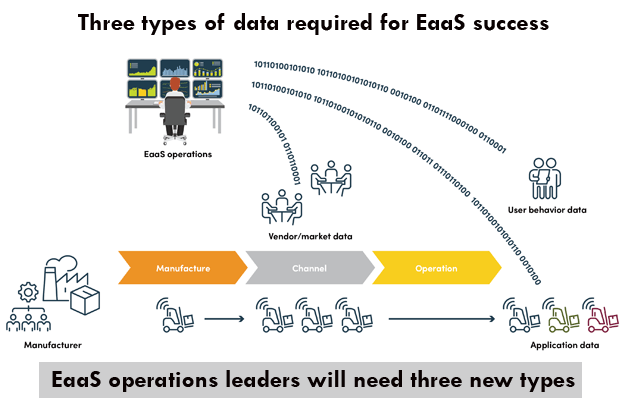
Ten bulldozers can have ten different applications within ten different industry segments. An EaaS business manager will need to find ways to match their bulldozer assets with bulldozer users AND bring the two together at the appropriate time to deliver on a contracted promise of service. As described in Part 1 of this article series, Equipment as a Service is a contract between a service provider and an end user, and success in EaaS will require new data to deliver on a contracted promise.
EaaS requires a shift from a traditional finance mindset centered on an asset, to that of a product manager who focuses on delivering an offering to users in an accountable and cost-effective manner for the customer. Product managers gather and analyze data on applications by segment, product performance by application, and user behavior throughout the lifecycle of the product. EaaS will require similar data to address the same and new analytics to implement the delivery of the service as contracted.
EaaS operations will need the same three key types of data upon which product managers rely:
- Equipment application data – user identification, needs, and location
- User behavior data – frequency, duration, type of application, outcomes
- Market data – personas and demographics, geographic distribution, value of demand
These same types of data and analysis are familiar to anyone who has engaged usage-based-financing (UBF), but the implementation is different. Traditional UBF has analysis of the applications, the use, and some market distribution. But traditional UBF contracts integrate pre-sale research into the contract for the asset, leaving the risk of usage and value of usage-based pricing, in the hands of the users. When all the estimates are accurate, both parties are happy. But any real-world variances disrupt the model, usually at a cost to the user.
These traditional UBF models could not work as subscriptions because the data necessary to manage variances in demand, user efficiency, user location, and application diversity was not available. This is where technology steps in to deliver Product Management data to the EaaS operator.
Right time, right place, and ready-to-go
The basics: the equipment is ready-to-go and in the possession of the user at the point of application. Meeting all three requirements is trivial for SaaS – the software travels via the cloud, the cloud is everywhere, and the user has access to the application via ubiquitous computing screens – laptops and smartphones. Software moves literally at the speed of light to almost anywhere.
This is not the case for equipment. Fortunately, most equipment today, particularly construction, trucking, agriculture, and manufacturing robotics are all outfitted with sensors and connected to the cloud. Most equipment today is part of the Internet of Things (IoT). Even the simplest IoT devices know who-am-I, where-am-I, how-do-I-feel, and what-am-I-doing. As such, the IoT provides the first type of data required – equipment application data.
Learning from and accounting for user behavior
Next up – users. Users control total usage time, the value of the usage via the jobs performed with the asset, and the condition of the asset via the use-and-abuse characteristics of the job and the operator. EaaS financiers to have to focus on three key metrics: runtime because subscriptions are by definition time-based so runtime is revenue, use and abuse because the next contract will be a function of the asset condition, and time and place of completion of the use because the asset will have to be physically and contractually reallocated to the next user. Even EaaS subscriptions for fully automated equipment like manufacturing robots will have users who put them into action and control their application, so user behavior data is key.
EaaS managers will have to analyze and action the activity types, typical usage durations, and locations of the assets when used if they are going to keep the asset in use and generate a return on the asset. EaaS operations will still require credit and payment analysis, but operational activity will become the key to addressing the variance in usage that has limited UBF to certain types of assets like copiers which do not move around, perform very uniform and measure tasks.
Recently transportation manufacturers have made investments in AI companies that aggregate usage data, driver behavior, and convert it to information that is useful to both the operators and the asset managers. Route planning, mileage, location, and load percentages are all variables that a transportation company uses for operational efficiency, but they are also the variables an EaaS vendor would need to properly account for and charge that transportation company for a truck. They are also the data types that an EaaS provider uses to understand the marketplace for the asset. Route planning in transportation is particularly interesting example of user behavior because it serves both the operator – get the load from point A to point B – and the EaaS company as the asset can be managed to the next customer pick-up location to start the next subscription.
Optimizing contract yield is a search for demand
A subscription interruption means a payment disruption. In EaaS the risk of continuous usage will be owned by the financier of the asset, not the user. This leads to the third critical data type – demand. Just like a Product Manager and EaaS manager needs to understand the general demand for a given asset before they make their first investment. Is there enough demand for this asset to support a subscription that continues to pay? But unlike the Product Manager of a physical product who sells once, the EaaS asset manager must anticipate that any one user will likely not be the only subscriber. If they were, then they would either buy or finance the asset using traditional constructs. The EaaS customer is attracted to the “pay only for what I use” promise which effectively distributes the cost of the asset, its financing, and depreciation over a group of users.
A good example of this customer expectation is demonstrated by custom harvesting services. These businesses own the harvesting equipment but sell and apply its use to individual farmers who otherwise would only need to use that equipment a very small amount of time during the year. The custom harvesting company succeeds by aggregating and scheduling harvesting demand in a way the makes economic sense to each farmer, i.e., their subscription price, and keep the harvesting equipment harvesting for the largest total amount of time. This could mean following the harvesting season geographically or modifying the asset to enable harvesting of multiple types of crops. The focus of the custom harvester is “keep the harvester moving and the payments coming.”
Custom harvester operators need deep knowledge of their customers harvesting needs in both time and space, the capabilities of the equipment, and the status of their equipment so that they can keep it operating. They typically harvest for the same customers each year, most often geographically co-located, which is, in effect, a subscription for the harvest service. The only difference between this model and an EaaS model is that the company that owns the asset also hires and manages the labor that operates the equipment. They control the user’s behavior. EaaS does not have that advantage and must find data that illuminates usage and demand.
Hardware-as-a-Service shows the way
"The fundamental challenge for HaaS companies is that SaaS billing apps are not asset aware." -- Zachary Kimball, founder and CEO of Hardfin.
Hardfin is an accounting platform built specifically for Hardware-as-a-Service, which is a manufacturer’s name for EaaS. HaaS is a model wherein the manufacturer switches from selling a piece of equipment once to selling continuously via a subscription in the same way a software vendor uses the Software-as-a-Service business model. The quote highlights how HaaS/EaaS requires both new data types, as described above, and new analytics in the form of accounting and contracting constructs to deliver subscriber expectations. Kimball uses the phrase “equipment aware contracts” and has built a new type of billing software for HaaS/EaaS businesses. This accounting and billing method uses the new types of data to meet the expectations of the asset owner and HaaS/EaaS customer simultaneously.
Hardfin has defined a list called the HaaS-100 that can be viewed as the EaaS equivalent of the Monitor 100 of equipment finance. The HaaS 100 is dominated by robotics manufacturers whose customers expect a “pay for what I use” experience and have been able to accommodate that expectation while generating maximum revenue and profit per asset. Hardfin is a pioneer in facilitating HaaS business models and thus provides real world examples for non-captive finance companies considering EaaS businesses.
EaaS may not revolutionize equipment finance because it does not apply equally well to all types of assets and not all equipment customers want to share usage and depreciation. BUT, since there are already numerous successful examples of EaaS and more emerging every year, opportunities exist for organizations that see the potential.
Because the technology infrastructure exists, those interested in EaaS can focus their energy on equipment that already talks – connected equipment with out-of-the-box IoT connections – as well as equipment for which user behavior is less ambiguous and easy to track (like medical diagnostics, manufacturing robotics, and ag harvesting). Those who are well positioned, from a vendor and market point of view, will need to consider how to switch from taking orders to demand forecasting. They must begin gathering the types of data that subscription businesses require (user behavior data) if they are going to be successful with an EaaS business model.